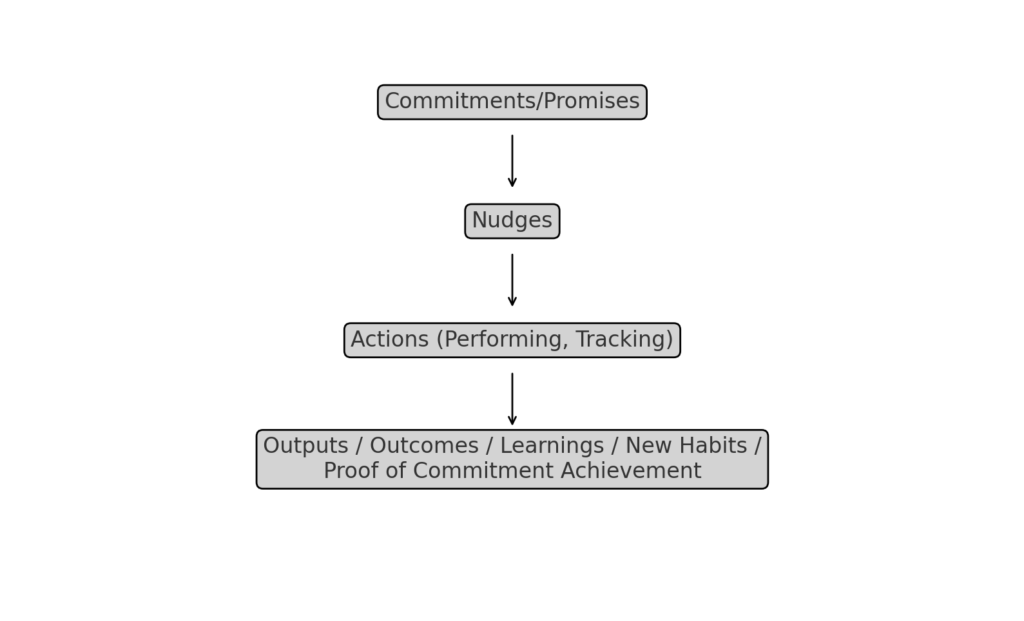Originally posted on billcraig.info

I had the pleasure of meeting up for a two hour coffee with the CEO of a company that has build a commitment-based nudging platform that helps people address self-limiting behavior in both life and work. The platform they are currently marketing is a great example of how technology can support behavioral psychology.
The more I discussed with the CEO and subsequent investigation/research I performed, I realized many of my entrepreneurial initiatives could make use of the approach and the platform. My initiatives around positive life, living and longevity; applying positive psychology techniques (interventions) to improve happiness, quality of life, and wellbeing; global flourish, flourishing enterprises and more could all benefit from the approach and the platform.
The discussion with the CEO also identified several additional use cases beyond what I could think of in our initial discussion
I had actually seen this done many years ago with the very successful Global Citizen initiative that used a similar approach to motivate people from around the world to commit and perform a large variety of socio-economic and political actions related to key global challenges – poverty, education…
As with everything I do these days, I needed to step back a do a little more research about behavioral psychology and commitment-based nudging and other mechanisms. I always was interested in how the approach could be applied beyond the individual. Could it be applied to teams, organizations, communities, regions and beyond.
A little bit of background:
Commitment-based nudging is a behavioral psychology technique that encourages individuals to follow through with their intentions or commitments by using social and psychological prompts. The idea is to leverage the human tendency to want to be consistent with their commitments and maintain a positive self-image.

Key Elements of Commitment-Based Nudging:
- Public Commitments:
- Making commitments public can increase the likelihood of following through. For example, announcing a goal to friends or family creates a social expectation and a sense of accountability.
- Written Commitments:
- Writing down commitments can make them more tangible and concrete. This can be as simple as signing a pledge or writing a personal contract.
- Incremental Steps:
- Breaking down commitments into smaller, manageable steps can make the overall goal less daunting and more achievable.
- Reminder Systems:
- Regular reminders, such as emails, texts, or calendar alerts, can help individuals stay on track with their commitments.
- Positive Reinforcement:
- Providing positive feedback or rewards for progress can reinforce the behavior and motivate individuals to continue.
Examples of Commitment-Based Nudging:
- Health and Fitness:
- A gym might encourage new members to sign a commitment contract that specifies their workout goals and frequency.
- Environmental Actions:
- Initiatives like pledging to reduce plastic use or to participate in recycling programs can use commitment-based nudging to foster environmentally friendly behaviors.
- Financial Goals:
- Financial institutions may use commitment savings accounts where individuals commit to regular deposits to reach a savings goal.
Psychological Mechanisms:
- Consistency Principle:
- People strive for consistency between their commitments and actions. Once they make a commitment, especially publicly or in writing, they are more likely to act in ways that align with it.
- Social Proof:
- Seeing others make similar commitments can create a sense of social pressure and motivation to follow through.
- Self-Perception:
- Committing to a goal can shape one’s self-perception, leading to behavior that aligns with the new self-image.
Commitment-based nudging effectively leverages these psychological principles to encourage positive behavioral changes and improve follow-through on intentions and goals.
Then I wanted to explore the use beyond just individuals:
delineates how various entities such as individuals, teams, organizations, enterprises, communities, and regions can utilize the features of commitment-based nudging in behavioral psychology.
| Entity | Public Commitments | Written Commitments | Incremental Steps | Reminder Systems | Positive Reinforcement |
|---|---|---|---|---|---|
| Individual | Share goals with friends or family | Write and sign personal goals or promises | Break down goals into smaller, manageable tasks | Set personal reminders on phone or calendar | Reward oneself for achieving milestones |
| Team | Announce team goals in meetings | Team members sign a collective agreement | Assign specific tasks to team members | Send regular updates and reminders via email or messaging | Recognize and celebrate team achievements |
| Organization | Publish organizational goals to all employees | Create formal documents for departmental objectives | Set quarterly targets and break down annual goals | Implement an internal newsletter or alert system | Offer incentives and bonuses for meeting targets |
| Enterprise | Publicly commit to sustainability or social goals | Formalize commitments through strategic documents | Develop a roadmap with clear milestones | Use enterprise-wide communication tools for reminders | Recognize partner organizations for contributions |
| Community | Hold town hall meetings to discuss community initiatives | Community members sign pledges for community projects | Break initiatives into phases (e.g., park cleanup phases) | Community bulletin boards, social media updates | Host community events to celebrate progress |
| Region | Public announcements of regional development plans | Regional leaders sign intergovernmental agreements | Develop step-by-step regional development plans | Regional newsletters, press releases, and social media | Regional awards and recognition programs |
Explanation of Features:
- Public Commitments:
- Individual: Sharing goals with close connections to create a sense of accountability.
- Team: Announcing team goals in meetings to foster a collective sense of purpose.
- Organization: Broadcasting organizational objectives to ensure all employees are aligned.
- Enterprise: Making commitments known to all stakeholders to demonstrate transparency and accountability.
- Community: Engaging community members in open forums to discuss and commit to initiatives.
- Region: Using public channels to announce plans, garnering support and collaboration from all regional stakeholders.
- Written Commitments:
- Individual: Writing personal goals to solidify intentions.
- Team: Team agreements to ensure everyone is on the same page.
- Organization: Departmental documents that outline objectives and expectations.
- Enterprise: Strategic documents that formalize enterprise-wide commitments.
- Community: Pledges from community members to participate in local projects.
- Region: Formal agreements between regional leaders to ensure cooperation.
- Incremental Steps:
- Individual: Dividing goals into smaller, actionable tasks to avoid being overwhelmed.
- Team: Assigning specific roles and tasks to team members to ensure progress.
- Organization: Setting quarterly targets to maintain focus and momentum.
- Enterprise: Creating a detailed roadmap to achieve long-term goals.
- Community: Phasing community projects to manage resources effectively.
- Region: Outlining step-by-step plans for regional development to ensure systematic progress.
- Reminder Systems:
- Individual: Personal alerts to keep goals top-of-mind.
- Team: Regular updates to ensure all members are aligned and informed.
- Organization: Internal communications to keep employees engaged with organizational goals.
- Enterprise: Communication tools to keep all stakeholders updated on progress.
- Community: Bulletins and social media updates to keep the community informed.
- Region: Using multiple channels to communicate progress and updates to the public.
- Positive Reinforcement:
- Individual: Self-rewards to stay motivated.
- Team: Celebrating team successes to build morale and motivation.
- Organization: Incentives to recognize and reward employee contributions.
- Enterprise: Recognizing partner contributions to foster a collaborative environment.
- Community: Community events to celebrate milestones and achievements.
- Region: Awards programs to recognize significant contributions to regional development.
One other area that lodged into my mind after exploring commitment-based nudging and behavioral psychology was the potential linkage to micro-learning platforms and of course AI. More on that in the near future.



